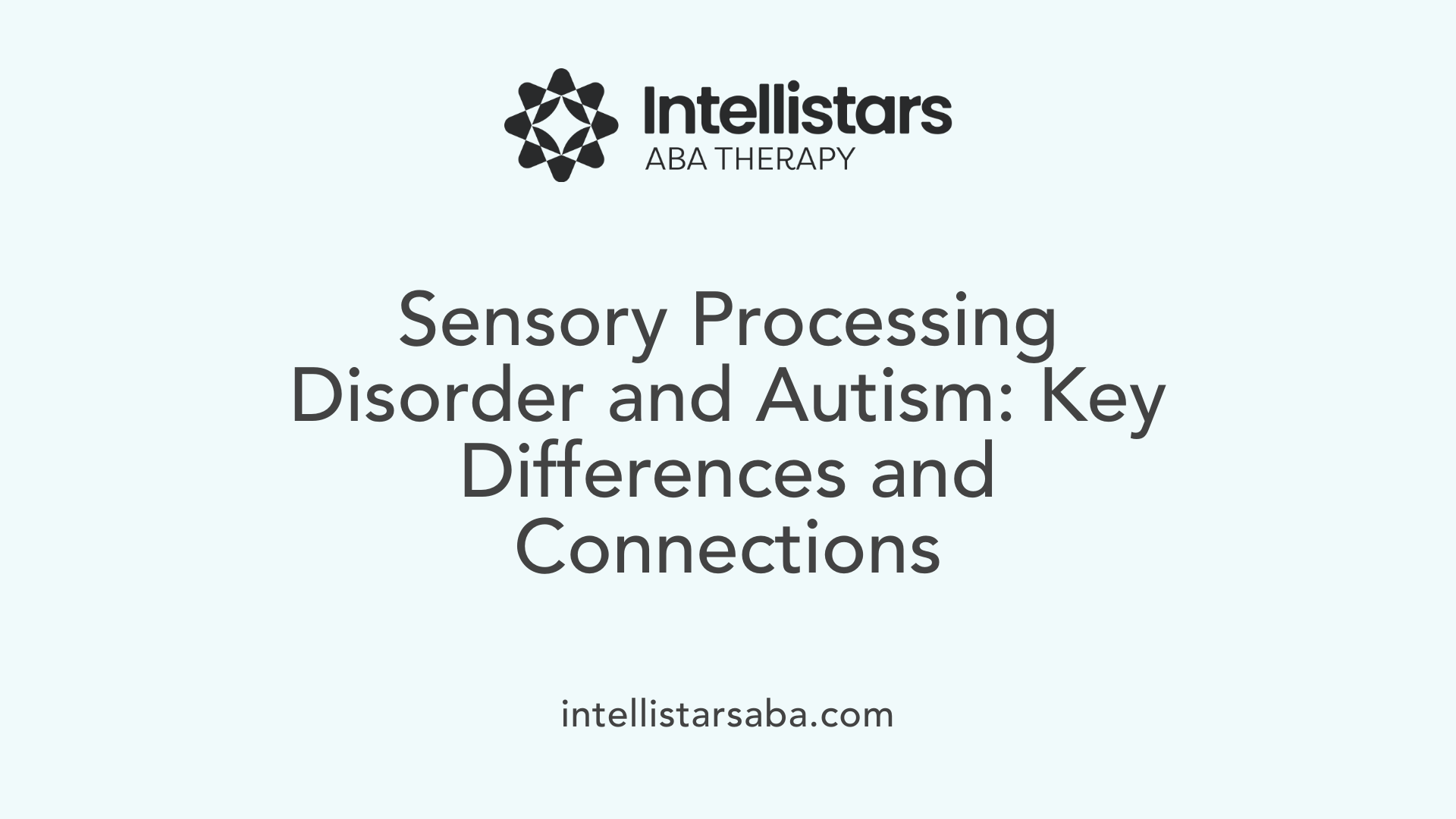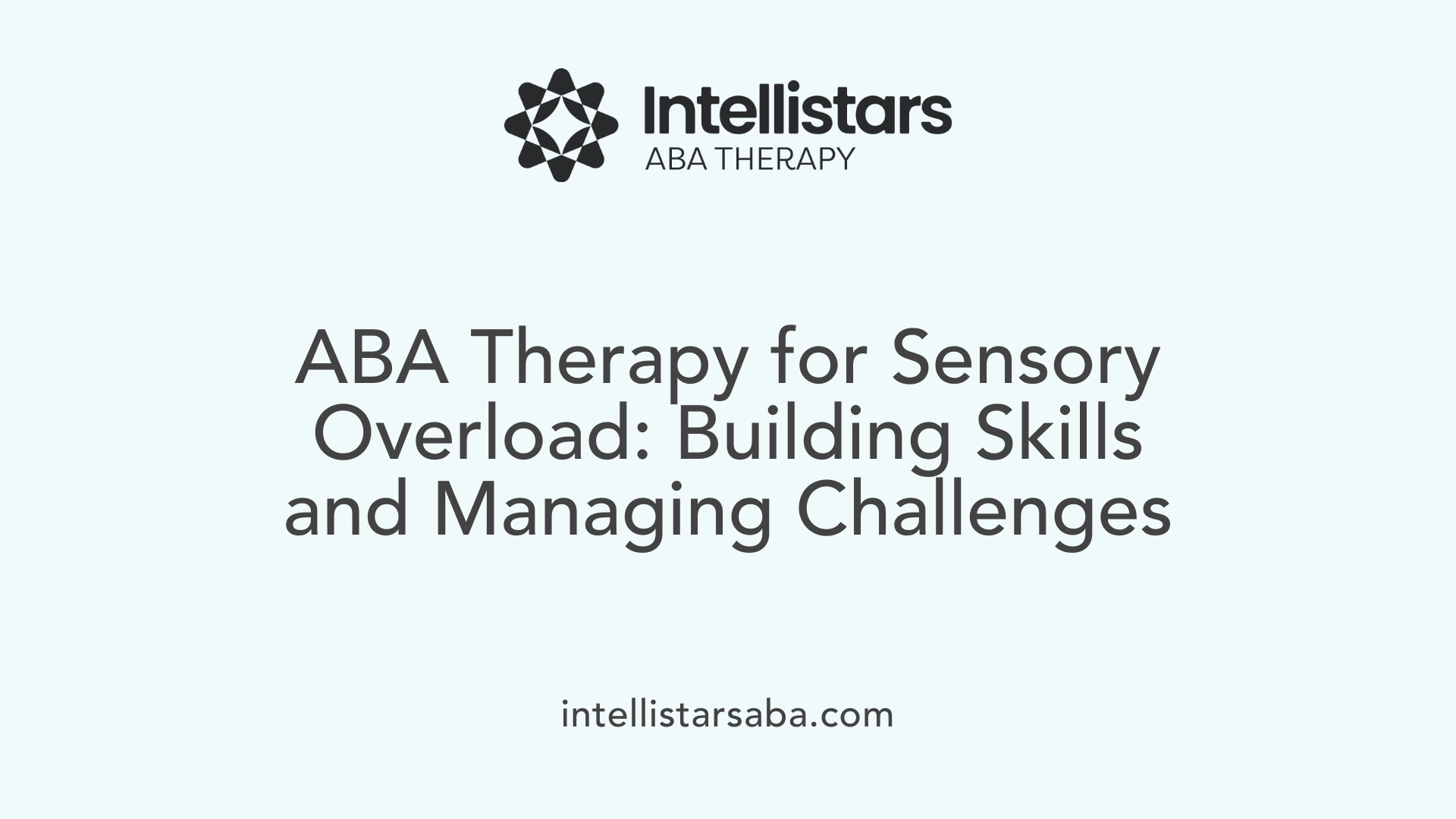Navigating the Complexities of Sensory Overload in Autism
Sensory overload and overstimulation are common experiences for many individuals with autism, profoundly affecting their daily lives and well-being. This article explores what sensory overload entails, its specific impact on autistic individuals, and evidence-based strategies—including behavioral analysis therapy—to manage and support those facing these challenges. We'll also clarify common misconceptions and highlight the importance of tailored interventions for sustainable improvement.
What Is Sensory Overload and How Does It Affect Individuals with Autism?

What Is Sensory Overload and Overstimulation?
Sensory overload, also known as overstimulation, happens when the brain receives more sensory information than it can effectively process. This can involve any combination of the five senses: taste, touch, sight, sound, and smell. When overwhelmed, the brain struggles to make sense of this heightened input, leading to distress and impaired functioning.
Sensory Overload in Autism and ADHD
Sensory overload is particularly prevalent in individuals with neurodevelopmental conditions like autism and Attention Deficit Hyperactivity Disorder (ADHD). People with autism often have heightened sensory sensitivities, making them more vulnerable to overstimulation. Similarly, individuals with ADHD may find it difficult to filter out sensory stimuli, which can result in discomfort and increased irritability.
Sensory Sensitivities and Symptom Patterns in Autism
Autistic individuals may exhibit hypersensitivity to sounds, lights, textures, and smells. These heightened sensitivities can trigger intense responses such as meltdowns—emotional outbursts—or shutdowns, characterized by withdrawal. Common behaviors aimed at coping with sensory input include stimming, like hand flapping, rocking, or touching certain textures to self-soothe.
Neurological Impacts of Sensory Overload
Neurologically, sensory overload activates the amygdala in the brain, which governs fear and stress responses. This activation can induce the fight, flight, or freeze reactions, manifesting as anxiety, panic, or social withdrawal. Understanding this neurological basis helps explain why sensory overload affects emotional regulation so profoundly.
Common Triggers and Resulting Behaviors
Typical triggers include loud or unexpected noises, bright or flickering lights, crowded or unpredictable environments, strong smells, and abrupt changes in routine. These triggers often provoke behaviors such as meltdowns, shutdowns, and increased stimming to manage overwhelming stimuli.
Signs and Symptoms to Recognize
Individuals experiencing sensory overload may show heightened irritability, restlessness, physical discomfort, and extreme fatigue. Other signs include withdrawal from social interaction, increased fidgeting or self-stimulatory behaviors, and a strong desire to block out sensory input by covering ears or eyes.
Understanding sensory overload in autism is vital for creating supportive environments that reduce distress and promote emotional well-being.
Distinguishing Sensory Processing Disorder and Its Connection to Autism

What is Sensory Processing Disorder (SPD) and What Types Exist?
Sensory Processing Disorder (SPD) refers to variations in how the brain interprets sensory information from the environment, affecting senses like sight, sound, touch, taste, and smell. SPD presents in several forms: sensory over-responsivity (heightened sensitivity to stimuli), sensory under-responsivity (reduced sensation), sensory craving (seeking intense sensory input), sensory discrimination disorder (difficulty distinguishing stimuli), postural disorder, and dyspraxia (coordination challenges).
What are the Symptoms and Their Effects?
Individuals with SPD may exhibit clumsiness, discomfort with fabrics or textures, gagging on certain foods, and persistent touching behaviors. These sensory differences can disrupt fine motor skills and emotional regulation, often leading to challenges in behavior and daily functioning.
How is SPD Related to Autism and ADHD?
SPD frequently co-occurs with neurodevelopmental conditions, notably autism spectrum disorder (ASD) and ADHD. Those with autism often experience sensory processing differences that can magnify the effects of SPD, influencing behaviors like avoidance or increased stimming. Similarly, ADHD individuals may struggle with filtering sensory information, compounding sensory-related discomfort.
Why is SPD Challenging to Diagnose?
Though SPD is clinically acknowledged, it remains outside formal medical diagnostic criteria. As a result, diagnosis largely depends on clinical observation by specialists such as occupational therapists and pediatricians, relying on symptom presentation rather than standardized tests.
What are Effective Management Strategies for SPD?
Occupational therapy, especially sensory integration therapy, is the principal approach to help individuals regulate sensory responses and cope with stimuli. Therapists may recommend practical modifications including sensory activities, the use of fidget toys, noise-canceling headphones, and scheduled sensory breaks to enhance concentration, behavior, and emotional well-being.
| Aspect | Details | Impact |
|---|---|---|
| Types | Over-responsivity, Under-responsivity, Craving, Discrimination, Postural, Dyspraxia | Varies from sensitivity to lack of sensation |
| Symptoms | Clumsiness, sensory discomfort, gagging, fine motor issues | Affects daily functions and behavior |
| Relation to Autism/ADHD | Common co-occurrence, worsens sensory challenges | Influences meltdowns, attention difficulties |
| Diagnosis | Clinical observation, no formal medical test | Can delay recognition and intervention |
| Management | Occupational therapy, sensory integration, environmental adjustments | Improves quality of life and emotional health |
Behavioral Analysis Therapy (ABA): Foundations and Providers
What is behavioral analysis therapy for autism?
Behavioral analysis therapy for autism, commonly known as Applied Behavior Analysis (ABA), is a science-based approach focused on improving socially meaningful skills. It is grounded in understanding how behavior is influenced by environmental factors through the ABC model (Antecedent-Behavior-Consequence).
ABA uses specific techniques like positive reinforcement, prompting, and shaping to encourage helpful behaviors such as communication, social skills, and self-care. Programs are personalized, often guided by a Board Certified Behavior Analyst (BCBA), and may include structured methods like Discrete Trial Training or more natural strategies like Pivotal Response Treatment.
The goal is not only to promote skill development but also to reduce disruptive behaviors. Extensive research supports ABA’s effectiveness in enhancing IQ, language, and daily functioning. While widely accepted as a best practice, ethical aspects and approaches of ABA continue to be discussed within the neurodiversity community.
Who provides behavioral analysis therapy for autism?
ABA therapy is primarily delivered by qualified behavior analysts, especially Board Certified Behavior Analysts (BCBAs). These experts design, supervise, and monitor individualized treatment plans. They collaborate with therapists, caregivers, and multidisciplinary teams to implement evidence-based interventions tailored to each individual.
Therapy can take place in various environments such as homes, schools, or clinics, with trained providers using data-driven methods. Family involvement plays a crucial role, as behavior analysts train and support caregivers to reinforce positive behaviors outside therapy sessions.
Accessing ABA services typically involves coverage through insurance plans, Medicaid, or other funding sources. Providers work to ensure that treatment adheres to professional and ethical standards.
Settings, team roles, and access pathways
| Setting | Role of Providers | Importance of Family Involvement |
|---|---|---|
| Home | BCBA oversight and therapists implement interventions | Families reinforce skills and support consistency |
| School | Collaboration with educators and specialists | Educators adapt approaches; caregivers communicate needs |
| Clinic | Structured sessions with direct therapist contact | Training for families to apply techniques at home |
Overall, ABA therapy's effectiveness relies on skilled providers, individualized treatment, and strong partnerships with families, supported by accessible funding and professional standards.
How ABA Therapy Helps Manage Sensory Overload and Supports Skill Development

Use of ABA Techniques to Reduce Problematic Behaviors Triggered by Sensory Overload
Applied Behavior Analysis (ABA) uses scientific methods to identify and reduce challenging behaviors caused by sensory overload in individuals with autism. Techniques such as positive reinforcement encourage alternative, more adaptive responses to sensory triggers. Modifications to the environment and structured interventions help decrease distressing behaviors like meltdowns and shutdowns that often result from overstimulation.
Development of Communication, Social, and Self-Regulation Skills
ABA therapy prioritizes building essential skills including communication, social interaction, and self-regulation. For example, individuals learn to express sensory needs effectively and develop coping strategies such as calming stimming behaviors or grounding techniques. These skills reduce anxiety and improve handling of sensory input, making day-to-day functioning smoother.
Personalized Plans Supervised by Qualified Analysts
Every ABA program is tailored to the individual's unique sensory profile and needs. Qualified behavior analysts design and monitor personalized intervention plans that focus on the specific sensory triggers and skill deficits experienced by the individual. This ensures targeted support that addresses both sensory challenges and overall developmental goals.
Benefits of Early and Intensive Intervention
Research shows that starting ABA therapy early and applying it intensively enhances outcomes for individuals with sensory processing difficulties. Early intervention supports quicker acquisition of communication and self-regulation skills, reducing behavioral issues linked to sensory overload and improving long-term independence.
Evidence of Improved Independence, Behavior, and Emotional Regulation Through ABA
Studies and clinical experience indicate that ABA leads to meaningful improvements in independence, behavior, and emotional regulation. By systematically teaching adaptive responses to sensory stimuli, individuals experience less distress, better emotional control, and increased ability to navigate complex sensory environments. This approach ultimately fosters greater quality of life and social engagement.
Recognizing and Managing Triggers of Overstimulation in Autism

Common Triggers of Overstimulation
Individuals with autism often face sensory overload due to environmental factors such as loud noises, bright or flickering lights, crowded spaces, and strong smells. These sensory inputs can quickly exceed their brain's processing ability, causing discomfort and distress.
Behavioral and Physical Symptoms
Signs of overstimulation include physical behaviors like covering ears or eyes, fidgeting, and pacing. Emotionally, individuals might display irritability, withdrawal, or tearfulness. These symptoms signal the need for intervention to prevent escalation.
Sensory-Friendly Environments
Creating sensory-friendly spaces is crucial to limit triggers. This can involve adjusting lighting, reducing noise, minimizing clutter, and providing quiet zones. Sensory tools such as noise-canceling headphones or weighted blankets help create a calming effect.
Routine, Calming Activities, and Sensory Tools
Maintaining a consistent routine can provide predictability, reducing the chance of unexpected sensory inputs. Calming activities and sensory tools like fidget toys support self-regulation and comfort before overstimulation occurs.
Role of Caregivers and Educators
Caregivers and educators play a vital role in identifying early signs of overstimulation. They can offer support through patient interaction, allowing breaks, and providing calming resources. Their understanding and timely response help minimize distress and promote well-being.
Strategies and Tools to Cope with Sensory Overload and Overstimulation
Creating Sensory-Friendly Environments: Noise Control, Adjustable Lighting, Quiet Spaces
Designing spaces that reduce sensory triggers is essential for managing sensory overload. Controlling noise levels by minimizing loud or sudden sounds can help prevent overstimulation. Adjustable lighting allows individuals to avoid brightness or flickering lights that may be overwhelming. Quiet, low-stimulus areas offer a safe retreat when sensory input becomes too intense.
Use of Sensory Tools Such As Noise-Canceling Headphones, Weighted Blankets, and Fidget Toys
Sensory tools provide manageable sensory input to self-soothe and regulate sensory experiences. Noise-canceling headphones help block out distracting or distressing sounds. Weighted blankets provide comforting deep pressure touch stimulation, which can calm the nervous system. Fidget toys and other tactile items offer a controlled sensory outlet to reduce anxiety and improve focus.
Techniques for Self-Regulation Including Deep Breathing, Grounding, Mindfulness, and Stimming
Techniques that promote self-regulation empower individuals to manage sensory overload before it escalates. Deep breathing exercises help reduce anxiety and lower physical tension. Grounding techniques, such as focusing on sensory details in the environment, help redirect overwhelming thoughts. Mindfulness encourages present-moment awareness to reduce stress. Stimming behaviors like rocking or touching textures serve as natural coping mechanisms to create soothing sensory input.
Importance of Calm Low-Stimulus Environments During Episodes
When sensory overload occurs, providing a calm and low-stimulus environment is critical. This space helps the individual recover by reducing additional sensory input and emotional distress. Reassurance and patience from caregivers or educators in these moments foster a supportive atmosphere conducive to calming down.
Avoiding Punitive Responses and Ensuring Supportive Approaches
It is vital to avoid punitive or harsh responses during episodes of overstimulation, as they can worsen distress and anxiety. Instead, adopting understanding and empathetic approaches nurtures trust and safety. Supporting self-expression of sensory needs and allowing time for recovery helps individuals regain regulation without added pressure.
| Strategy | Purpose | Examples |
|---|---|---|
| Sensory-Friendly Environment | Reduce sensory triggers | Noise control, adjustable lighting, quiet spaces |
| Sensory Tools | Provide manageable sensory input | Noise-canceling headphones, weighted blankets, fidget toys |
| Self-Regulation Techniques | Empower individual coping | Deep breathing, grounding exercises, mindfulness, stimming |
| Calming Spaces During Episodes | Facilitate recovery from overload | Quiet rooms, low lighting, reassurance |
| Supportive Responses | Minimize distress, foster trust | Avoid punishment, show patience, encourage communication |
Long-term Support: Building Resilience and Encouraging Self-Regulation
Teaching Communication Strategies to Express Sensory Needs
Helping individuals with autism communicate their sensory experiences is crucial for managing overstimulation. Tools such as visual supports, picture cards, and simple phrases enable them to indicate when they feel overwhelmed or need adjustments in their environment. These strategies foster independence and reduce anxiety by giving a clear way to express discomfort before overload occurs.
Gradual Exposure to Sensory Stimuli While Respecting Personal Boundaries
Gradual, respectful exposure to sensory triggers can build tolerance over time. This approach involves identifying triggers and slowly introducing them at manageable levels, ensuring the individual’s pace and limits are honored. Avoiding forced exposure protects against heightened distress and encourages positive coping development.
Reflecting on Triggers Through Observation and Sensory Journals
Keeping sensory journals or detailed observations helps identify specific stimuli that cause overstimulation. Monitoring patterns provides insight into environmental adjustments needed and assists caregivers and therapists in tailoring individualized strategies. This reflection also aids in preventing future sensory overload episodes.
Professional Support Including Occupational Therapy and Behavioral Interventions
Occupational therapy, especially sensory integration therapy, plays a vital role in long-term management. Therapists design personalized activities that teach regulation and coping skills for sensory input. Behavioral interventions, such as those aligned with Applied Behavior Analysis (ABA), use evidence-based practices to reduce overload episodes and improve emotional regulation.
Family and Caregiver Education to Implement ABA-Aligned Strategies
Educating families and caregivers on sensory processing differences and effective strategies empowers consistent support. Training in ABA principles and sensory management allows for creating predictable, calming environments and reinforces self-regulatory behaviors. Well-informed caregivers contribute significantly to the individual’s success in navigating sensory challenges.
Adult Perspectives: Sensory Overload Challenges and Supports
Sensory Overload in Autistic Adults and Common Triggers
Sensory overload in autistic adults happens when sensory inputs like sounds, lights, and smells exceed what their brain can comfortably process. Common triggers include loud noises, bright or flickering lights, crowded places, and strong odors. These overwhelming sensations can make everyday environments challenging for autistic adults.
Symptoms of Sensory Overload in Adults
When overloaded, autistic adults may show signs such as withdrawing from social interactions or environments, experiencing irritability or increased emotional reactions, and physical symptoms like headaches and a racing heart. Behavioral changes such as repetitive movements or increased restlessness can also indicate sensory overload.
Strategies for Prevention and Management Adapted for Adults
Preventing sensory overload involves creating sensory-friendly spaces by adjusting lighting, controlling noise levels, and reducing clutter. Adults benefit from using sensory tools like noise-canceling headphones or weighted blankets. Grounding techniques such as mindfulness, deep breathing exercises, and purposeful stimming behaviors help manage acute episodes of overload. Establishing calming routines and scheduled sensory breaks supports emotional regulation.
Value of Professional Support, Therapy, and Peer Groups
Access to occupational therapy or specialized professional support is critical for developing personalized coping strategies. Therapy can teach self-regulation skills and help address sensory sensitivities. Peer support groups also provide a community where autistic adults share experiences and strategies, reducing feelings of isolation.
Education and Awareness to Reduce Stigma and Improve Quality of Life
Raising awareness about sensory overload in adults helps caregivers, employers, and society understand these challenges better. Educating others reduces stigma and fosters environments that accommodate sensory needs, ultimately improving the quality of life for autistic adults. Caregiver education aligned with evidence-based practices promotes empathy and effective support strategies.
Creating Compassionate, Effective Support for Sensory Challenges in Autism
Sensory overload and overstimulation present significant challenges for individuals with autism across the lifespan, affecting their behavior, emotional regulation, and daily functioning. Understanding these sensory processing differences and the neurological underpinnings is vital for providing empathetic and effective support. Behavioral analysis therapy offers an evidence-based framework to reduce challenging behaviors, develop vital skills, and improve quality of life. Combined with occupational therapy, sensory tools, environmental modifications, and informed caregiver involvement, a comprehensive approach can empower individuals to navigate sensory experiences more comfortably and build resilience. Ultimately, fostering awareness and implementing individualized strategies creates safer, more inclusive environments where neurodiverse individuals can thrive.
References
- What is sensory overload? What you need to know
- ABA Tips: Overstimulation & Autism
- Sensory Processing Disorder (SPD): Symptoms & Treatment
- Overstimulation in Autism: Why it Happens & How to ...
- How to Calm Down from Overstimulation: A Step-by- ...
- Applied Behavior Analysis (ABA)
- 6 Benefits of ABA Therapy for Children with Autism
- Effects of Applied Behavior Analysis on individuals with ...






